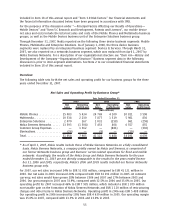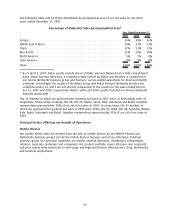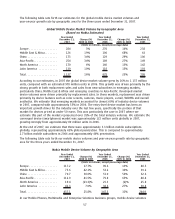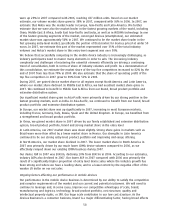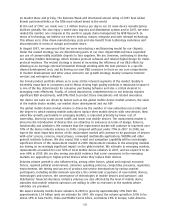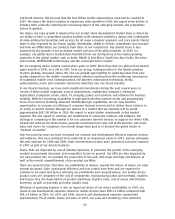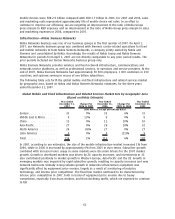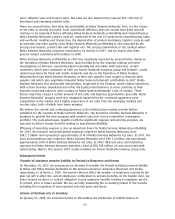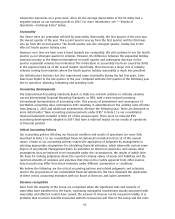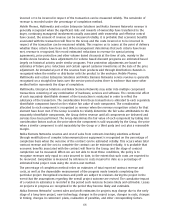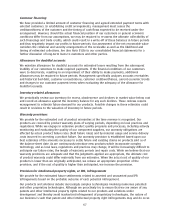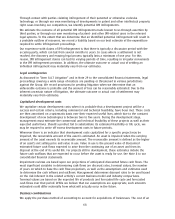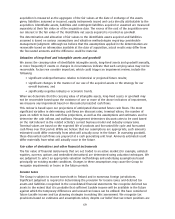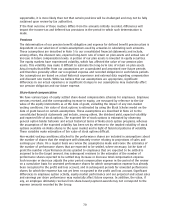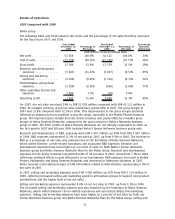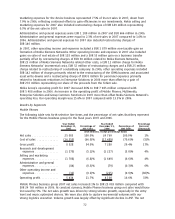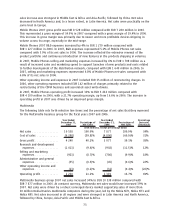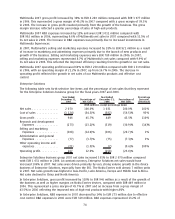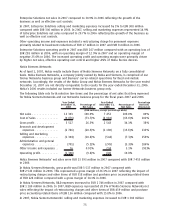Nokia 2007 Annual Report Download - page 66
Download and view the complete annual report
Please find page 66 of the 2007 Nokia annual report below. You can navigate through the pages in the report by either clicking on the pages listed below, or by using the keyword search tool below to find specific information within the annual report.transaction exposures on a gross basis. All in all, the average depreciation of the US dollar had a
negative impact on our operating profit in 2007. For more information, see “—Results of
Operations—Exchange Rates” below.
Seasonality
Our device sales are somewhat affected by seasonality. Historically, the first quarter of the year was
the lowest quarter of the year. The second quarter was up from the first quarter and the third was
also up from the second quarter. The fourth quarter was the strongest quarter, mainly due to the
effect of fourth quarter holiday sales.
However, over time we have seen a trend towards less seasonality. We still continue to see the fourth
quarter as our strongest quarter in volumes. However, the difference between the sequential holiday
seasonal increase in the Western hemisphere in fourth quarter and subsequent decrease in first
quarter sequential volumes has moderated. The moderation in seasonality has been caused by shifts
in the regional make up of the overall market. Specifically, there has been a larger mix of industry
volumes coming from markets where the fourth quarter holiday seasonality is much less prevalent.
Our infrastructure business has also experienced some seasonality during the last few years. Sales
have been higher in the last quarter of the year compared with the first quarter of the following year
due to operators’ planning, budgeting and spending cycle.
Accounting developments
The International Accounting Standards Board, or IASB, has and will continue to critically examine
current International Financial Reporting Standards, or IFRS, with a view toward increasing
international harmonization of accounting rules. This process of amendment and convergence of
worldwide accounting rules continued in 2007 resulting in amendments to the existing rules effective
from January 1, 2008 and additional amendments effective the following year. These are discussed in
more detail under “New accounting pronouncements under IFRS” in Note 1 to our consolidated
financial statements included in Item 18 of this annual report. There were no material IFRS
accounting developments adopted in 2007 that have a material impact on our results of operations
or financial position.
Critical Accounting Policies
Our accounting policies affecting our financial condition and results of operations are more fully
described in Note 1 to our consolidated financial statements included in Item 18 of this annual
report. Certain of our accounting policies require the application of judgment by management in
selecting appropriate assumptions for calculating financial estimates, which inherently contain some
degree of uncertainty. Management bases its estimates on historical experience and various other
assumptions that are believed to be reasonable under the circumstances, the results of which form
the basis for making judgments about the reported carrying values of assets and liabilities and the
reported amounts of revenues and expenses that may not be readily apparent from other sources.
Actual results may differ from these estimates under different assumptions or conditions.
We believe the following are the critical accounting policies and related judgments and estimates
used in the preparation of our consolidated financial statements. We have discussed the application
of these critical accounting estimates with our Board of Directors and Audit Committee.
Revenue recognition
Sales from the majority of the Group are recognized when the significant risks and rewards of
ownership have transferred to the buyer, continuing managerial involvement usually associated with
ownership and effective control have ceased, the amount of revenue can be measured reliably, it is
probable that economic benefits associated with the transaction will flow to the Group and the costs
65


